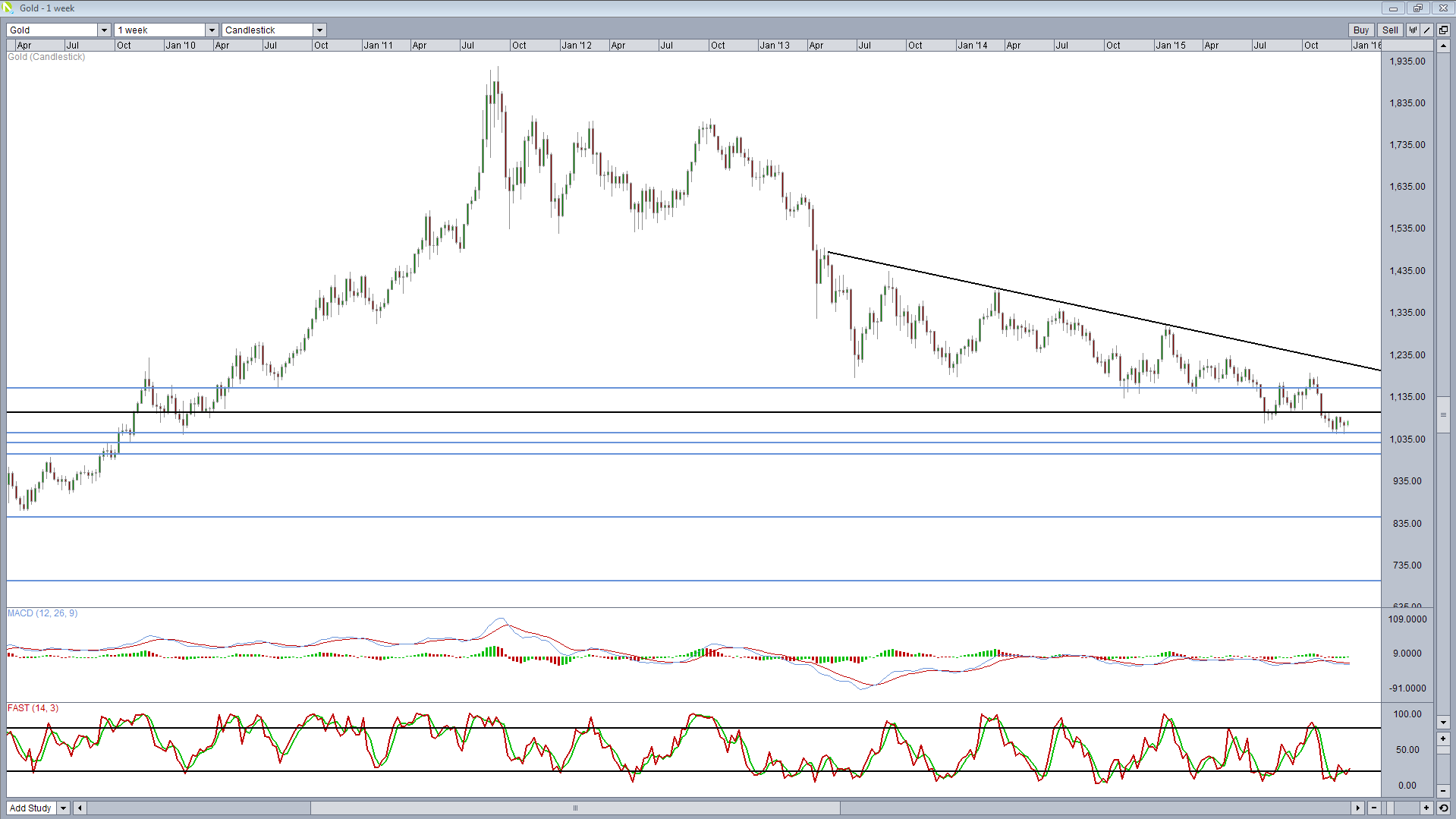- Gold down 9 percent year-to-date
- Monetary policy to keep pressure on commodity prices
- Asian central banks demand to grow
- Geopolitical risks decoupled
The yellow metal is on track to record another negative year in 2015. Gold’s high price point occured on January 22 ($1,305) as safe haven flows boosted the metal after the shock decision by the Swiss National Bank (SNB) to unpeg the Swiss franc versus the EUR. What followed for the remainder of the year was a steady decline as gold decoupled from geopolitical events that in years past had appreciated the price of the commodity in times of uncertainty. Monetary policy easing form major central banks have kept interest rates at record lows, and with energy prices continuing to drop global inflationary pressures remain a non issue for the time being; further reducing the appetite for the yellow metal.
XAU/USD is down 9 percent from last year, and while there are some bright spots in the horizon, 2016 is looking like another challenging year for the metal.

Central Bank Actions to Keep Pressure on Gold Prices
In a coordinated effort after the credit crisis of 2008 central banks cut rates to record lows around the world in an effort to boost growth. The strategy has had mixed results and in some cases it was an expensive proposition. The U.S. Federal Reserve started its tightening of monetary policy in December with the first rate hike in nearly a decade and is expected to follow it with multiple upward rate changes in 2016. The USD has strengthened on the expectation of higher rates next year putting downward pressure on the price of gold in particular when low inflation is taken into consideration. Several members of the Fed have said that the rate hike would not wait for higher inflation and so far that has been the case.
China, India and Russia Demand to Grow
Giving some hope to the yellow metal are the central banks of China, India and Russia. Collectively, China and India account for two thirds of the global demand for gold. Chinese and Indian demand fell 25% and 3% respectively, but given the low prices there is room for opportunistic buys as investors in those nations look for alternative asset classes.
Global gold consumption dropped 12% in the second half of 2015, to a six-year low, as key buyers in Asia lost their appetite for the metal. One buyer who has moved against the tide is the People’s Bank of China (PBoC) which has increased its gold reserves to 1,743 tons by the end of November. The central banks of China and Russia have increased their holdings and kept the price of gold from crashing below $1,000.
The fact that western central banks usually hold about 60 percent of reserves in gold compared to the paltry 1.6 percent of China translates to a assurance of further demand if the price continues to trade in the current range as the PBoC looks to diversify its reserves.
Geopolitical Risks Decoupled but not Forgotten
Low inflation has reduced the appetite for the yellow metal more than the apparent decoupling from geopolitical turmoil. Historically energy and gold prices have risen during international conflict but as information is exchanged faster and the market is able to price in several major events gold has been muted even as tensions have been high. The geopolitical agenda is filled with potential clashes as China and Japan both increase defence spending with an eye on the China seas. Turkey and Russia are the latest nations to be on opposite sides of conflict with their involvement in the Syrian/ISIS fight. Elections around the world will also add uncertainty to the markets with the highlight being the U.S. presidential elections that has the potential to bring a new direction to U.S. politics.
The correlation between the price of gold and major conflicts has been reduced in the past two years, but as central banks continue to unshackle volatility, and in some cases they are the main source, investors will be on the lookout for a safe haven asset which bodes well for gold next year.
Gold Producers Have FX Silver Lining
With the price of gold dangerously close to $1,000 mining stocks are big losers as they have been forced to cut back to survive the reduction in revenue due to falling prices. There is a psychological level that gets mentioned that producers need at least $1,200 per ounce to break even on extraction costs. Mines located in emerging markets will provide better results due to the effect of a weaker currency on operating costs. With softer demand outside of the central banks of Russia and China forecasted the mining industry will have to seek further consolidations and find ways to reduce costs as it strives to survive another challenging year.
Technical Analysis
It’s been another year in which gold has continued its slow grind lower and there is nothing in the charts that suggests this about to change. It is currently finding support around $1,050 – its lowest levels since the start of 2010 – but a move below $1,000 looks very much on the cards. Gold spent much of 2008 and 2009 trading between $850 and $1,000 and this could become an interesting range for it again in 2016. The fundamental environment doesn’t offer much upside for gold – low inflation and rising US interest rates – and even geopolitical shocks haven’t had the usual effect of promoting its safe haven appeal. Should $850 be broken, we could be looking at a move back towards $700, support in October and November 2008 and quite a common ceiling prior to the financial crisis. While we at MP expect gold to remain on the bearish side in 2016, a break above the descending trend line – 3 May 2013 highs – may indicate a bullish sentiment shift, especially if accompanied by a move above $1,180, the most recent peak in October.

